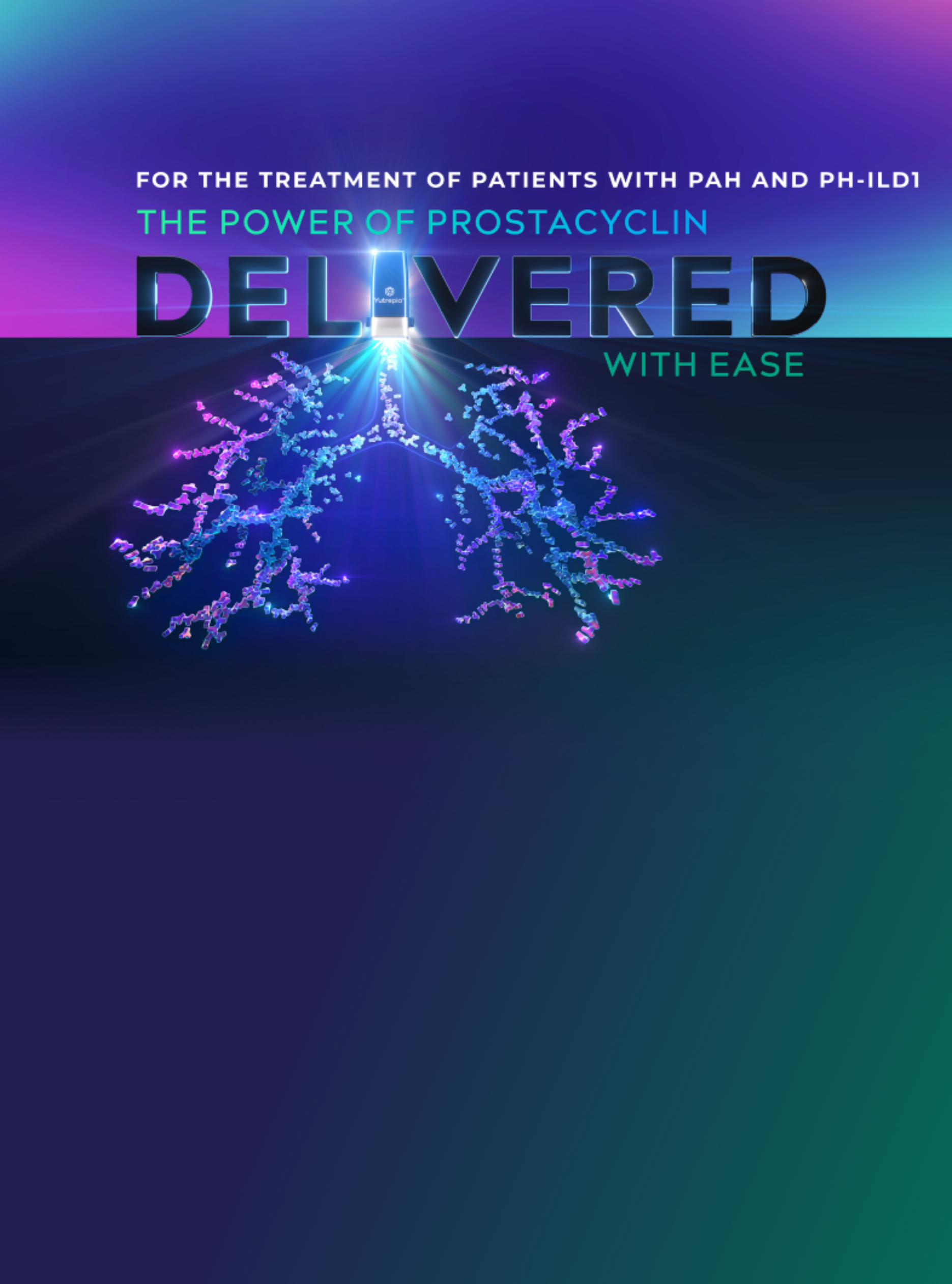INDICATION
YUTREPIA™ is a prostacyclin mimetic indicated for the
treatment of:
-
Pulmonary arterial hypertension (PAH; WHO Group 1) to
improve exercise ability. Studies establishing
effectiveness predominately included patients with NYHA
Functional Class III symptoms and etiologies of
idiopathic or heritable PAH (56%) or PAH associated with
connective tissue diseases (33%).
-
Pulmonary hypertension associated with interstitial lung
disease (PH-ILD; WHO Group 3) to improve exercise
ability. The study establishing effectiveness
predominately included patients with etiologies of
idiopathic interstitial pneumonia (IIP) (45%) inclusive
of idiopathic pulmonary fibrosis (IPF), combined
pulmonary fibrosis and emphysema (CPFE) (25%), and WHO
Group 3 connective tissue disease (22%).
IMPORTANT SAFETY INFORMATION
WARNINGS AND PRECAUTIONS
-
Treprostinil is a pulmonary and systemic vasodilator. In
patients with low systemic arterial pressure, treatment
with treprostinil may produce symptomatic hypotension.
-
Treprostinil inhibits platelet aggregation and increases
the risk of bleeding.
-
Co-administration of a cytochrome P450 (CYP) 2C8 enzyme
inhibitor (e.g., gemfibrozil) may increase exposure (both
Cmax and AUC) to treprostinil.
Co-administration of a CYP2C8 enzyme inducer (e.g.,
rifampin) may decrease exposure to treprostinil. Increased
exposure is likely to increase adverse events associated
with treprostinil administration, whereas decreased
exposure is likely to reduce clinical effectiveness.
-
Like other inhaled prostaglandins, YUTREPIA may cause
acute bronchospasm. Patients with asthma or chronic
obstructive pulmonary disease (COPD), or other bronchial
hyperreactivity, are at increased risk for bronchospasm.
Ensure that such patients are treated optimally for
reactive airway disease prior to and during treatment with
YUTREPIA.
DRUG INTERACTIONS/SPECIFIC POPULATIONS
-
The concomitant use of treprostinil with diuretics,
antihypertensives, or other vasodilators may increase the
risk of symptomatic hypotension.
-
Human pharmacokinetic studies with an oral formulation of
treprostinil (treprostinil diolamine) indicated that
co-administration of the cytochrome P450 (CYP) 2C8 enzyme
inhibitor, gemfibrozil, increases exposure (both Cmax
and AUC) to treprostinil. Co-administration of the CYP2C8
enzyme inducer, rifampin, decreases exposure to
treprostinil. It is unclear if the safety and efficacy of
treprostinil by the inhalation route are altered by
inhibitors or inducers of CYP2C8.
-
Limited case reports of treprostinil use in pregnant women
are insufficient to inform a drug-associated risk of
adverse developmental outcomes. However, pulmonary
arterial hypertension is associated with an increased risk
of maternal and fetal mortality. There are no data on the
presence of treprostinil in human milk, the effects on the
breastfed infant, or the effects on milk production.
-
Safety and effectiveness in pediatric patients have not
been established.
-
Placebo-controlled clinical studies of treprostinil
inhalation solution did not include sufficient numbers of
patients aged 65 years and over to determine whether they
respond differently from younger patients. The open label
INSPIRE study in patients with PAH included 28 patients
aged 65 and over in which no age-related differences were
noted. In general, dose selection for an elderly patient
should be cautious, reflecting the greater frequency of
hepatic, renal, or cardiac dysfunction, and of concomitant
diseases or other drug therapy.
-
Uptitrate slowly when treating patients with hepatic
insufficiency because of the risk of an increase in
systemic exposure which may lead to an increase in
dose-dependent adverse effects. Treprostinil has not been
studied in patients with severe hepatic insufficiency.
-
No dose adjustments are required in patients with renal
impairment. Treprostinil is not cleared by dialysis.
ADVERSE REACTIONS
-
PAH (WHO Group 1): The safety and tolerability of YUTREPIA
was evaluated in an open label study (INSPIRE) of 121
patients with PAH (WHO Group 1 and NYHA Functional Class
II [80 patients] and Class III [41 patients]) followed for
up to 2 months. The most commonly reported adverse
reactions included cough, headache, throat irritation,
dizziness, which are known side effects of treprostinil
inhalation solution. The adverse reactions in the INSPIRE
study were consistent with those observed in previous
studies of inhaled treprostinil.
-
PH-ILD (WHO Group 3): In a 16-week, placebo-controlled
study of 326 patients with PH-ILD (WHO Group 3), adverse
reactions with inhaled treprostinil were similar to the
experience in studies of PAH.
Please see
Full Prescribing Information
for YUTREPIA.



